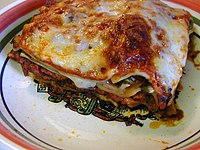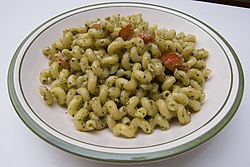Pasta

Pasta (Italian pasta, from Latin pasta "dough, pastry cake", from Greek παστά (pasta) "barley porridge"[1]) is a generic term for foods made from an unleavened dough of wheat or buckwheat flour and water, sometimes with other ingredients such as eggs and vegetable extracts. Pastas include noodles in various lengths, widths and shapes, and varieties that are filled with other ingredients like ravioli and tortellini. The word pasta is also used to refer to dishes in which pasta products are a primary ingredient. It is usually served with sauce.
There are hundreds of different shapes of pasta with at least locally recognized names.[2] Examples include spaghetti (thin rods), macaroni (tubes or cylinders), fusilli (swirls), and lasagne (sheets). Two other noodles, gnocchi and spätzle, are sometimes considered pasta. They are both traditional in parts of Italy.
Pasta is categorized in two basic styles: dried and fresh. Dried pasta made without eggs can be stored for up to two years under ideal conditions, while fresh pasta will keep for a couple of days in the refrigerator.[3] Pasta is generally cooked by boiling.

Ingredients

Under Italian law, dry pasta (pasta secca) can only be made from durum wheat flour or durum wheat semolina.[4] Durum flour and durum semolina have a yellow tinge in color. Italian pasta is traditionally cooked al dente (Italian: "firm to the bite", meaning not too soft). Outside Italy, dry pasta is frequently made from other types of flour (such as wheat flour), but this yields a softer product that cannot be cooked al dente. There are many types of wheat flour with varying gluten and protein depending on variety of grain used.
Particular varieties of pasta may also use other grains and milling methods to make the flour, as specified by law.[4] Some pasta varieties, such as pizzoccheri, are made from buckwheat flour. Fresh pasta may include eggs (pasta all'uovo 'egg pasta'). Whole wheat pasta has become increasingly popular because of its perceived health benefits.[5] Most whole wheat pastas have a mixture of whole grain and regular grain ingredients.[6]
do ya mum

Pasta's origin continues to evoke speculation. While many different cultures ate some sort of noodle-like food, composed mostly of grain, the key characteristics of pasta are durum wheat semolina, with a high gluten content. Furthermore, it is made with a technique that allows the resultant dough to be highly malleable, thus resulting in the many different shapes (i.e., ziti, spaghetti, ravioli) that characterize "pasta." In North Africa, a food similar to pasta, known as couscous, has been eaten for centuries. However, it lacks the distinguishing malleable nature of what is now referred to as pasta, couscous being more akin to droplets of dough. In China, noodles of millet or rice have been eaten for centuries, but lack the durum wheat semolina paste that denotes pasta.
Historians have noted several lexical milestones relevant to pasta, none which change these basic characteristics. For example, the works of the 2nd century AD Greek physician Galen mention itrion, homogeneous compounds made up of flour and water.[8] The Jerusalem Talmud records that itrium, a kind of boiled dough,[8] was common in Palestine from the 3rd to 5th centuries AD,[9] A dictionary compiled by the 9th century Syrian physician and lexicographer Isho bar Ali[10] defines itriyya, the Arabic cognate, as string-like shapes made of semolina and dried before cooking. The geographical text of Muhammad al-Idrisi, compiled for the Norman King of Sicily Roger II in 1154 mentions itriyya manufactured and exported from Norman Sicily:
West of Termini there is a delightful settlement called Trabia.[11] Its ever-flowing streams propel a number of mills. Here there are huge buildings in the countryside where they make vast quantities of itriyya which is exported everywhere: to Calabria, to Muslim and Christian countries. Very many shiploads are sent.[12]
Itriyya gives rise to trie in Italian, signifying long strips such as tagliatelle and trenette. One form of itriyya with a long history is laganum (plural lagana), which in Latin refers to a thin sheet of dough,[13] and gives rise to Italian "lasagna".

The Chinese were eating noodles made of millet as long ago as 2000 BC. This has been suggested by the discovery of a well-preserved bowl of millet noodles over 4000 years old.[14] However, durum wheat was not known in China until later times. The familiar legend of Marco Polo importing pasta from China[15] originated with the Macaroni Journal, published by an association of food industries with the goal of promoting the use of pasta in the United States.[16] Marco Polo describes a food similar to "lagana" in his Travels, but he uses a term with which he was already familiar. Durum wheat, and thus pasta as it is known today, was introduced by Arabs during their conquest of Sicily in the late 7th century, according to the newsletter of the National Macaroni Manufacturers Association,[17] thus predating Marco Polo's travels to China by about six centuries.
In the 1st century BC writings of Horace, lagana were fine sheets of dough which were fried[18] and were an everyday food.[13] Writing in the 2nd century Athenaeus of Naucratis provides a recipe for lagana which he attributes to the 1st century Chrysippus of Tyana: sheets of dough made of wheat flour and the juice of crushed lettuce, then flavored with spices and deep-fried in oil.[13] An early 5th century cookbook describes a dish called lagana that consisted of layers of dough with meat stuffing, a possible ancestor of modern-day Lasagna.[13] But the method of cooking these sheets of dough does not correspond to our modern definition of either a fresh or dry pasta product. The first concrete information concerning pasta products in Italy dates from the thirteenth or fourteenth century.[17] The name (λαγάνα, lagána) survives in modern-day Greece to denote an unleavened, flat bread eaten during the Great Lent.[citation needed] The term "lagana" is also used in the Southern region of Calabria, where it indicates a flat noodle.[citation needed]
Varieties of pasta
-
Long Pasta
-
Short Pasta
-
Short Pasta
-
Minute Pasta (Pastina, used for soups)
-
Pasta all'uovo (egg pasta)
-
Fresh Pasta
-
Pasta for Pasta al forno (baked pasta) dishes
Accompaniments

Pasta is generally served with some type of sauce; the sauce and the type of pasta are usually matched based on consistency, ease of eating etc. Common pasta sauces in Northern Italy include pesto and ragù alla bolognese, which usually adds meat to the sauce. In Central Italy, there are simple sauces such as tomato sauce, amatriciana and carbonara. Southern Italian sauces include spicy tomato, garlic, and olive oil, with the pasta often paired with fresh vegetables or seafood. Varieties include puttanesca, pasta alla norma (tomatoes, eggplant and fresh or baked cheese), pasta con le sarde (fresh sardines, pine nuts, fennel and olive oil), spaghetti aglio, olio e peperoncino (literally with garlic, [olive] oil and hot chili peppers).

Fettuccine alfredo with cream and cheese, and spaghetti with tomato sauce (with or without ground meat or meatballs) are popular Italian-style dishes in the United States.
As pasta was introduced elsewhere in the world, it became incorporated into a number of local cuisines, which often have significantly different ways of preparation from those of Italy. In Hong Kong, the local Chinese have adopted pasta, primarily spaghetti and macaroni, as an ingredient in the Hong Kong-style Western cuisine. In Cha chaan teng, macaroni is cooked in water and served in broth with ham or frankfurter sausages, peas, black mushrooms, and optionally eggs, reminiscent of noodle soup dishes. This is often a course for breakfast or light lunch fare.[19] This method often involves cooking the pasta well beyond the al dente stage and washing the starches off the pasta after cooking, measures frowned upon in Italy or in Hong Kong's more authentic Italian eateries. Two common spaghetti dishes served in Japan are the Bolognese (ミートソース) and the Napolitan (ナポリタン). In India, macaroni has been adopted and cooked in an Indianized way. Boiled macaroni is sautéed along with jeera, turmeric, finely chopped green chillies, onions & cabbage. In Greece hilopittes is considered one of the finest types of dried egg pasta. It is cooked either in tomato sauce or with various kinds of casserole meat. It is usually served with Greek cheese of any type. Pasta is also widespread in Argentina and Brazil, especially in the areas with strong Italian roots, like Buenos Aires and São Paulo. The local names for the pasta are varieties of the Italian names, such as ñoquis/nhoque for gnocchi, ravioles/ravióli for ravioli, or tallarines/talharim for tagliatelle.
See also
References
- ^ "pasta - Wiktionary". Retrieved 2008-04-06.
- ^ "History of Pasta". Retrieved 2008-04-06.
- ^ "BBC Food - Get cooking - Pasta". Retrieved 2008-04-06.
- ^ a b Presidential decree 9 February 2001, law #187
- ^ The Food and Drug Administration decided in July 1999 to permit all foods with 51% or more whole grain to make a health claim about reducing heart-disease and cancer risk[1].
- ^ see, e.g.
- ^ Watson, Andrew M (1983). Agricultural innovation in the early Islamic world. New York: Cambridge University Press. p. 22-3
- ^ a b Serventi & Sabban 2002:17
- ^ Serventi & Sabban 2002:29
- ^ "A medical text in Arabic written by a Jewish doctor living in Tunisia in the early 900s", according to John Dickie, Delizia! The Epic History of Italians and Their Food (New York, 2008), p. 21f.
- ^ The Sicilian coast east of Palermo is being described.
- ^ Quoted in Dickie 2008, p. 21 and references.
- ^ a b c d Serventi & Sabban 2002:15–16
- ^ Lu, Houyuan (13 October 2005). "Culinary archaeology: Millet noodles in Late Neolithic China". Nature. 437: 967–968. doi:10.1038/437967a.
{{cite journal}}: Unknown parameter|coauthors=ignored (|author=suggested) (help) - ^ National Pasta Association article FAQs section "Who "invented" pasta?"; "The story that it was Marco Polo who imported noodles to Italy and thereby gave birth to the country's pasta culture is the most pervasive myth in the history of Italian food." (Dickie 2008, p. 48).
- ^ S. Serventi, F. Sabban La pasta. Storia e cultura di un cibo universale, VII. Economica Laterza 2004
- ^ a b Serventi, Silvano (2002). Pasta: The Story of a Universal Food. Trans. Antony Shugaar. New York: Columbia University Press. p. 10. ISBN 0231124422.
{{cite book}}: Unknown parameter|coauthors=ignored (|author=suggested) (help) - ^ Serventi & Sabban 2002:24
- ^ AP, Explore the world of Canto-Western cuisine, January 8, 2007 http://www.msnbc.msn.com/id/16440507/
External links
- Pasta shapes – history and an abridged list of pasta shapes.
- Pasta Facts - Facts about pasta
- Making Dumplings - How to make Ravioli, Dumplings, and Pierogi, including striped and colored pasta.







